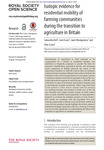Search
Now showing items 41-48 of 48
Isotopic evidence for residential mobility of farming communities during the transition to agriculture in Britain
(2016)
Development of agriculture is often assumed to be accompanied by a decline in residential mobility, and sedentism is frequently proposed to provide the basis for economic intensification, population growth and increasing ...
Trophic niche divergence among colour morphs that exhibit alternative mating tactics
(2016)
Discrete colour morphs associated with alternative mating tactics are assumed to be ecologically equivalent. Yet suites of behaviours linked with reproduction can also favour habitat segregation and exploitation of different ...
Tight knit under stress
(2015)
The movement of colonies from one nest to another is a frequent event in the lives of many social insects and is important for their survival and propagation. This goal-oriented task is accomplished by means of tandem ...
Unexpected monophyletic origin of Ephoron shigae unisexual reproduction strains and their rapid expansion across Japan
(2015)
The burrowing polymitarcyid mayflyEphoron shigaeis distri-buted across Japan, Korea, northeast China and far east Russia. Some populations are bisexual, and others are unisexual, i.e. geographically parthenogenetic throughout ...
The relationship between pond habitat depth and functional tadpole diversity in an agricultural landscape
(2015)
One of the most important goals of biodiversity studies is to identify which characteristics of local habitats act as filters that determine the diversity of functional traits along environmental gradients. In this study, ...
Models of fertilization kinetics
(2015)
Fertilization functions describe how the number of realized fertilizations depends on gamete numbers or density. They provide insight into the fertilization process, and are important components in models on the evolution ...
Coexistence of three sympatric cormorants
(2016)
Resource partitioning is well known along food and habitat for reducing competition among sympatric species, yet a study on temporal partitioning as a viable basis for reducing resource competition is not empirically ...
Are genes faster than crabs?
(2014)
Biological invasions offer unique opportunities to investigate evolutionary dynamics at the peripheries of expanding pop-ulations. Here, we examine genetic patterns associated with admixture between two distinct invasive ...








